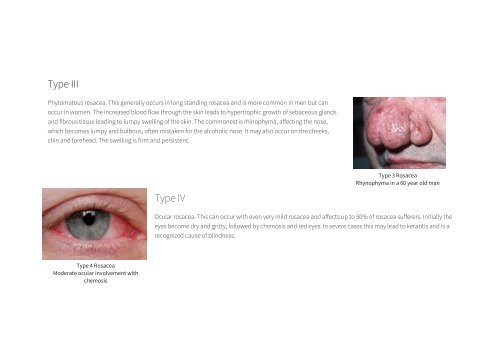Acne and Rosacea Charity Training Manual
You also want an ePaper? Increase the reach of your titles
YUMPU automatically turns print PDFs into web optimized ePapers that Google loves.
Type III<br />
Phytomatous rosacea. This generally occurs in long st<strong>and</strong>ing rosacea <strong>and</strong> is more common in men but can<br />
occur in women. The increased blood flow through the skin leads to hypertrophic growth of sebaceous gl<strong>and</strong>s<br />
<strong>and</strong> fibrous tissue leading to lumpy swelling of the skin. The commonest is rhinophyma, affecting the nose,<br />
which becomes lumpy <strong>and</strong> bulbous, often mistaken for the alcoholic nose. It may also occur on the cheeks,<br />
chin <strong>and</strong> forehead. The swelling is firm <strong>and</strong> persistent.<br />
Type 3 <strong>Rosacea</strong><br />
Rhynophyma in a 60 year old man<br />
Type IV<br />
Ocular rosacea. This can occur with even very mild rosacea <strong>and</strong> affects up to 50% of rosacea sufferers. Initially the<br />
eyes become dry <strong>and</strong> gritty, followed by chemosis <strong>and</strong> red eyes. In severe cases this may lead to keratitis <strong>and</strong> is a<br />
recognized cause of blindness.<br />
Type 4 <strong>Rosacea</strong><br />
Moderate ocular involvement with<br />
chemosis



